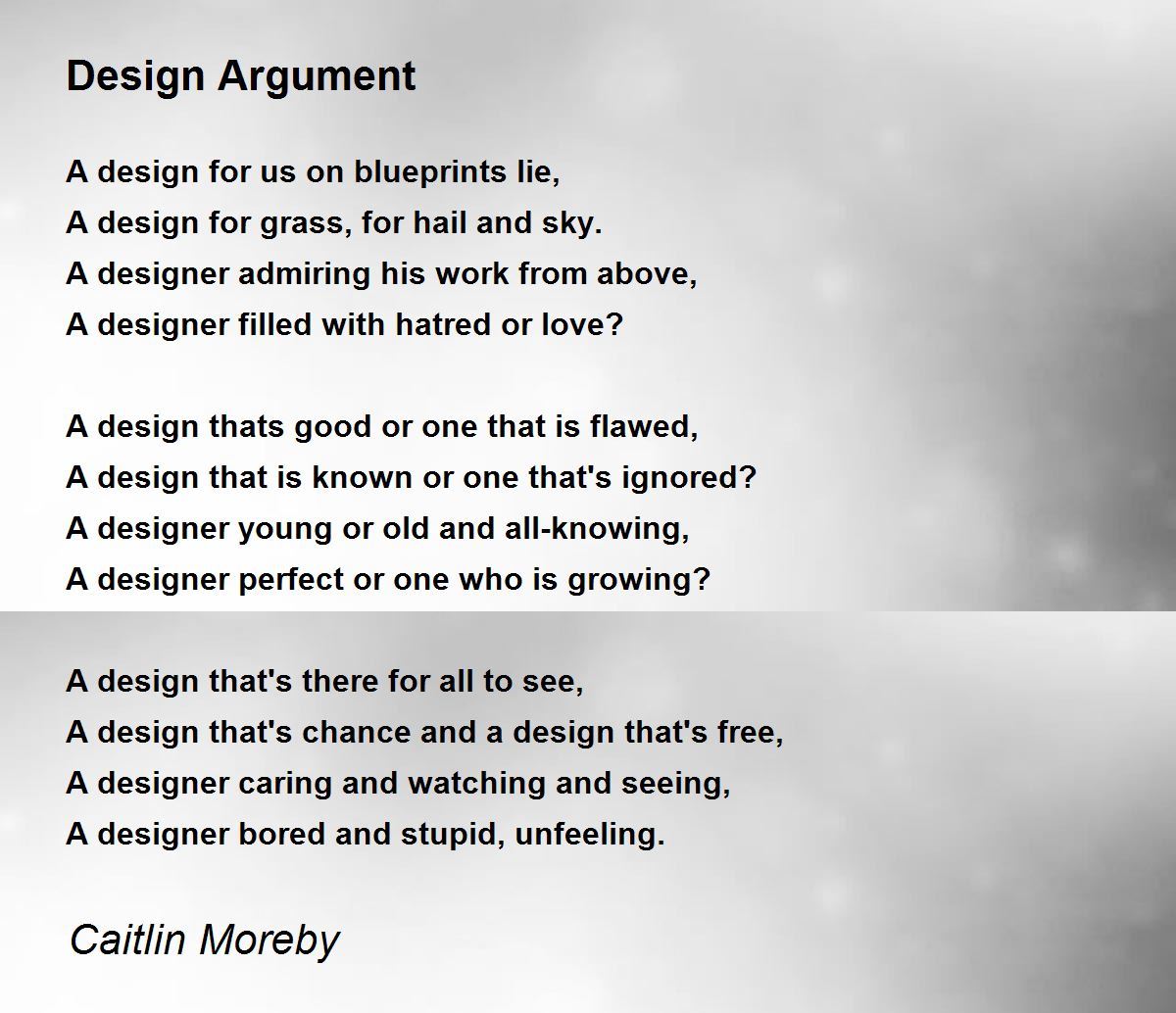Table Of Content

Let C stand for a fine-tuned parameter with physicallypossible values in the range [0, ∞). If we assume that nature isnot biased toward one value of C rather than another, theneach unit subinterval in this range should be assigned equalprobability. Fine-tuning is surprising insofar as the life-permittingrange of C is tiny compared to the full interval, whichcorresponds to a very small probability. It might be held that (6) is known in the sameconceptual, nearly a priori way in which we knowthat textbooks are not producible by natural processes unaided bymind. And our conviction here is not based on any mere induction fromprior experiences of texts.
Part V. Thomas Aquinas, "The Argument from Design"
Why the Argument from Suboptimal Design Is Weak - Discovery Institute
Why the Argument from Suboptimal Design Is Weak.
Posted: Thu, 20 Dec 2012 08:00:00 GMT [source]
It's entirely possible that there are many fine tuned universes "out there" that an intelligent God created. But their existence is entirely speculative and beyond science with no relevance to the fine tuning argument. So while a religious person might choose to believe in them for one reason or another, it wouldn't help atheistic scientists escape the conclusion of an intelligent cause. Your intelligent designer produced our solar system with a finite life; the sun, a nuclear furnace, as it consumes its fuel, will expand and destroy the earth and the rest of the solar system. Your intelligent designer also produced genetic defects, harmful bacteria and viruses with devastating effects on human beings and numerous other examples of poor design.

The Design Argument according to William Paley
For what can be known about God is plain to them, because God has shown it to them. Ever since the creation of the world his eternal power and divine nature, invisible though they are, have been understood and seen through the things he has made. We have already considered relation, and under different views; but it was the relation of parts to parts, of the parts of an animal to other parts of the same animal, or of another individual of the same species.
II. Contemporary resources A. Books
Inphysics, a property found for almost all of the solutions to anequation requires no explanation; it’s what one should expect.It’s not unusual, for instance, for a pin balancing on its tipto fall over. The argument for fine-tuning can thus be recastsuch that almost all values of C are outside of thelife-permitting range. The fact that our universe is life-permittingis therefore in need of explanation. There is also the potential problem of new, previously unconsideredhypotheses all lumped together in the catch-all basket. Withoutknowing the details of what specific unconsidered hypotheses mightlook like, there is simply no plausible way to anticipate the apparentlikelihood of a novel new hypothesis.
1 Introducing Naturalness
From the classical Greek era through the time of modem science, leading thinkers, from Plato to Aquinas to Newton, have maintained that nature manifests design. However, Hume in his Dialogues Concerning Natural Religion leveled a devastating attack on the classical design argument, one from which many believe the argument never fully recovered. Hume pointed out various problems with the analogy of order in Nature to a designer.
As remarked in Section 2.3, string theory has an enormous number of lowest energy states (vacua),which would manifest themselves at the level of observations andexperiments in terms of different higher level physical laws andvalues of the constants. This so-called landscape multiversequalifies as a concrete multiverse scenario in the sense of theargument from fine-tuning for the multiverse. A necessary condition isof course that the collection of island universes that are part of thelandscape multiverse includes, as is widely believed to be the case,at least one universe with the same effective (higher-level) laws andconstants as our own. Our best current theories of fundamental physics are the StandardModel of elementary particle physics and the theory of generalrelativity. The Standard Model accounts for three of the known fourfundamental forces of nature—the strong, the weak, and theelectromagnetic force—while general relativity accounts for thefourth—gravity.
Evolutionary theory provides a means of exploring the origin of complex adaptations using a variety of analytical approaches (e.g., fossil record, genetics, comparative anatomy and physiology, phylogenetics, developmental biology), rather than drawing a conclusion based on the observation of complexity alone. Evolutionary theory, which includes more than adaptive mechanisms, also provides a straightforward explanation for suboptimality, vestigial traits, and wastefulness, including excessive complexity and redundancy where simpler solutions could easily be envisioned. One of the most obstinate misconceptions about evolutionary theory is that it hypothesizes that eyes and other complex organs arise “by chance.” Even under the most charitable assessment, such a view of adaptive evolution must be considered deeply misguided. Whereas genetic mutation is both integral to the process and indeed is random with respect to its effects, natural selection is, by definition, the nonrandom survival and reproduction of individuals. Variation is generated at random, but whether or not it is preserved depends on its effects on survival and reproduction within a given environmentFootnote 11 (for reviews, see Gregory 2008, 2009). No serious evolutionary biologist of the past 150 years has suggested that the emergence of complex organs is merely the result of chance.
Concerning your last point, there is no reason to posit that the intelligent cause is constrained. After all, the cause of everything can not be constrained by anything external to it. We aren't claiming God is constrained, or forced, to make atoms, molecules, planets, life, stars, or galaxies.
Since the works of nature possess functional complexity, a reliable indicator of intelligent design, we can justifiably conclude that these works were created by an intelligent agent who designed them to instantiate this property. As Darwin noted, Paley’s thesis that the appearance of design must in fact be the outcome of design was refuted by the advent of a workable theory of evolutionary change. Nevertheless, 150 years later, biologists are still awed—but are no longer stunned—by complexity in natural systems.
The problem, of course, is not the notion that great variety may arise by chance and be narrowed by differential survival—this is the basis of natural selection as it is now understood. Rather, the implausibility of Paley’s scenario is the scale at which he considered the process. Specifically, he envisioned an unconstrained morphospace in which drastically divergent species continually pop into existence. This lies in stark contrast to Darwin’s later emphasis on small-scale variation arising within species and then being sorted generation by generation. Just because there is only one solution to the design argument (God), doesn’t imply that an intelligent God could only make one type of universe. After all, it clearly deviates from the well-established scientific method rooted in the process of hypothesis, experimentation, and observation.
It is immediately tempting to think that the probability of a fine-tuned universe is so small that intelligent design simply must be the more probable explanation. The supposition that it is a matter of chance that so many things could be exactly what they need to be for life to exist in the universe just seems implausibly improbable. Since, on this intuition, the only two explanations for the highly improbable appearance of fine-tuning are chance and an intelligent agent who deliberately designed the universe to be hospitable to life, the latter simply has to be the better explanation. Pre-biotic natural selection and chemical necessity cannot, as a logical matter, explain the origin of biological information.
The “teleological argument,” better known as the “argument from design,” is the claim that the appearance of “design” in nature—such as the complexity, order, purposefulness, and functionality of living organisms—can only be explained by the existence of a “designer” (typically of the supernatural variety). In its most familiar manifestation, the argument from design involves drawing parallels between human-designed objects (e.g., telescopes, outboard motors) and biological counterparts with similar functional roles (e.g., eyes, bacterial flagella). The former are complex, often indivisibly so if they are to maintain their current function, clearly perform specific functions, and are known to have been the product of intentional design. The functional complexity of living organisms is far greater still, it is argued, and, therefore, must present even stronger evidence for the role of intelligent agency. A designed organism would, on the face of it, be in contradiction to evolutionary theory.
One of the most plausible arguments for the existence of God is the argument from design. This argument proceeds by pointing out how all things in the world seem fitted to one another, something that is also true of all the elements of each organism. It then points out that, when we find design in created things – from watches to books – we know that they were created by someone. Reasoning by analogy, the claim is that the world must also have a creator, only one with much greater intellect and power than any human being.
Schlesinger’s fine-tuning argument also appears vulnerable to the same criticism as the other versions of the design argument (see Himma 2002). While Schlesinger is undoubtedly correct in thinking that we are justified in suspecting design in the case where John wins three consecutive lotteries, it is because—and only because—we know two related empirical facts about such events. Without at least one of these two pieces of information, we are not obviously justified in seeing design in such cases. While there is much more to say about fine-tuning and about why the multiverse is a bad philosophical theory, to fully clinch the argument it’s even more important to formulate a clear, coherent, compelling idea of God that answers commonly raised questions against the theory of an intelligent cause. Nevertheless, we hope this basic presentation can help you appreciate that the fine-tuning argument from modern physics is a prime representative of the ancient design argument in the modern world.
The mere fact that certain sequences take a certain shape that we can see meaning or value in, by itself, tells us nothing obvious about the probability that it is the result of intelligent design. Attempts to apply the notion of logical probability tofine-tuning for life are beset with difficulties as well. Criticsargue that, from a logical point of view, arbitrary real numbers arepossible values of the constants (McGrew et al. 2001; Colyvan et al.2005). According to them, any probability measure over the realnumbers as values of the constants that differs from the uniformmeasure would be arbitrary and unmotivated.

No comments:
Post a Comment